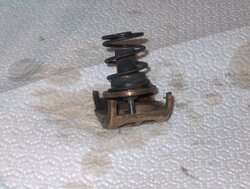After fighting with damp wood and some other issues, I had to start my system up from dead cold including the storage tank. What I noticed was that once the boiler was up to temp and started circulating the water temp dropped off rapidly and the pump cut out until the boiler was back up to temp again. I thought the Termovar valve was supposed to bleed hot water into the return to maintain 160 degrees until the return was up to temp. What I get is water as cold as 145 and as hot as 168 once I got the house warm and the tank backup to temp. This leads me to believe the valve is stuck somewhere in the middle. I called Bioheat and Randy suggested I take it out, open it up and see if anything is caught in there.
I'm a little hesitant to remove this when the temp is dropping so low. If I break it then I'm SOL until I can get a new one or by pass it.
Any precautions I need to take? Anybody else had to mess with the valve?
Thanks
Greg H
I'm a little hesitant to remove this when the temp is dropping so low. If I break it then I'm SOL until I can get a new one or by pass it.
Any precautions I need to take? Anybody else had to mess with the valve?
Thanks
Greg H


